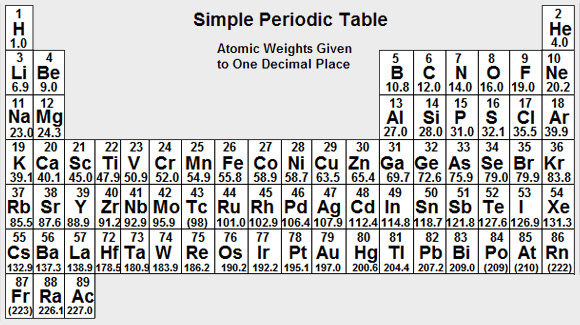For the next question, click on the Next Question button.
Question 1 of 5
The concentration of Sucrose in Syrup BP is 66.7 % w/w. If the density of the Syrup is 1.332 g/ml, what is the concentration of Sucrose expressed as % w/v? Answer to 1 decimal place.
- Find the volume of 100 g of Syrup - use the given density of 1.332 g/ml.
1.332 g of Syrup has a volume of 1 ml. Thus:
100 g of Syrup has a volume of 100/1.332 ml = 75.075 ml -
Find the mass of Sucrose in 100 ml of solution.
75.075 ml of solution contains 66.7 g of Sucrose. Thus:
100 ml of solution contains 100/75.075 x 66.7 g of Sucrose
100 ml of solution contains 88.84 g of Sucrose
No, that is not the correct answer.
Have another go: just type in your new answer and press Enter.
If you continue to have problems, have a look at the answer.
For the next question, click on the Next Question button.
Question 2 of 5
What is the molarity of a 36 % w/w solution of Formaldehyde (RMM 30.0) if the density of the solution is 1.08 g/ml? Answer to 4 significant figures.
- Find the volume of 100 g of solution - use the given density of 1.08 g/ml.
1.08 g of solution has a volume of 1 ml. Thus:
100 g of solution has a volume of 100/1.08 ml = 92.59 ml -
Find the number of moles of Formaldehyde in 100 g or 92.59 ml of solution.
100 g of solution contains 36 g of Formaldehyde. Thus:
92.59 ml of solution contains 36 g of Formaldehyde. Thus:
Moles of Formaldehyde = Mass/RMM = 36/30.0 = 1.2 moles -
Find the number of moles of Formaldehyde in 1000 ml of solution.
92.59 ml of solution contains 1.2 moles of Formaldehyde. Thus:
1000 ml of solution contains 1000/92.59 x 1.2 = 12.960 moles of Formaldehyde.
No, that is not the correct answer.
Have another go: just type in your new answer and press Enter.
If you continue to have problems, have a look at the answer.
For the next question, click on the Next Question button.
Question 3 of 5
What is the molality of a 36 % w/w solution of Formaldehyde? Answer to 4 significant figures.
- Find the mass of solvent associated with 36 g of Formaldehyde.
100 g of solution contains 36 g of Formaldehyde. Thus:
Mass of Solvent = Mass of Solution - Mass of Formaldehyde = 100 - 36 g = 64 g -
Find the mass of Formaldehyde associated with 1000 g of solvent.
64 g of solvent are associated with 36 g of Formaldehyde. Thus:
1000 g of solvent are associated with 1000/64 x 36 g = 562.5 g of Formaldehyde -
Find the number of moles of Formaldehyde associated with 1000 g of solvent.
562.5 g of Formaldehyde are associated with 1000 g of solvent. Thus:
Moles of Formaldehyde = Mass/Rmm = 562.5/30.0 moles = 18.750 moles
ie 18.75 molal to 4 sig figs.
No, that is not the correct answer.
Have another go: just type in your new answer and press Enter.
If you continue to have problems, have a look at the answer.
For the next question, click on the Next Question button.
Question 4 of 5
What is the mole fraction of Sodium Chloride in a 0.9 % w/w aqueous solution of Sodium Chloride? (RMM of Water = 18.02). Answer to 4 decimal places.
- Find the mass of water present in 100 g of solution.
100 g of solution contains 0.9 g of Sodium Chloride. Thus:
Mass of Water = Mass of Solution - Mass of NaCl = 100 - 0.9 g = 99.1 g -
Find the mole fraction of Sodium Chloride.
Moles of Sodium Chloride = Mass/RMM = 0.9/58.5 = 0.01538 moles
Moles of Water = Mass/RMM = 99.1/18.02 = 5.4995 moles
Mole Fraction of Sodium Chloride = Moles of Sodium Chloride
Moles of Sodium Chloride + Moles of Water
Mole Fraction of Sodium Chloride = 0.01538 = 0.00278
0.01538 + 5.4995
Mole Fraction of Sodium Chloride = 0.0028 to 4 dec pl
No, that is not the correct answer.
Have another go: just type in your new answer and press Enter.
If you continue to have problems, have a look at the answer.
Question 5 of 5
What is the normality of a solution containing 3.2 % w/w Sodium Acid Phosphate BP (RMM 156.0)? The density of the solution is 1.008 g/ml. Answer to 4 significant figures.
- Find the number of equivalents of Sodium Acid Phosphate (SAP) in 100 g of solution.
100 g of solution contains 3.2 g of Sodium Acid Phosphate.
Mass of One SAP Equivalent = RMM/Valency = 156.0/1 = 156.0 g
Number of SAP Equivalents = Mass of SAP/Mass of One Equivalent = 3.2/156.0 Eq
Number of SAP Equivalents = 0.020512 Eq -
Find the VOLUME of 100 g of solution - use the given density of 1.008 g/ml.
1.008 g of solution has a volume of 1 ml. Thus:
100 g of solution has a volume of 100/1.008 = 99.206 ml -
Find the number of equivalents in 1000 ml of solution.
99.206 ml of solution contains 0.020512 equivalents of SAP. Thus:
1000 ml of solution contains 1000/99.206 x 0.020512 Eq = 0.20676 Eq
No, that is not the correct answer.
Have another go: just type in your new answer and press Enter.
If you continue to have problems, have a look at the answer.
of that component in 1000 cm3 of the total system.
of the number of moles of that component to the total number
of moles of all components within the system.
